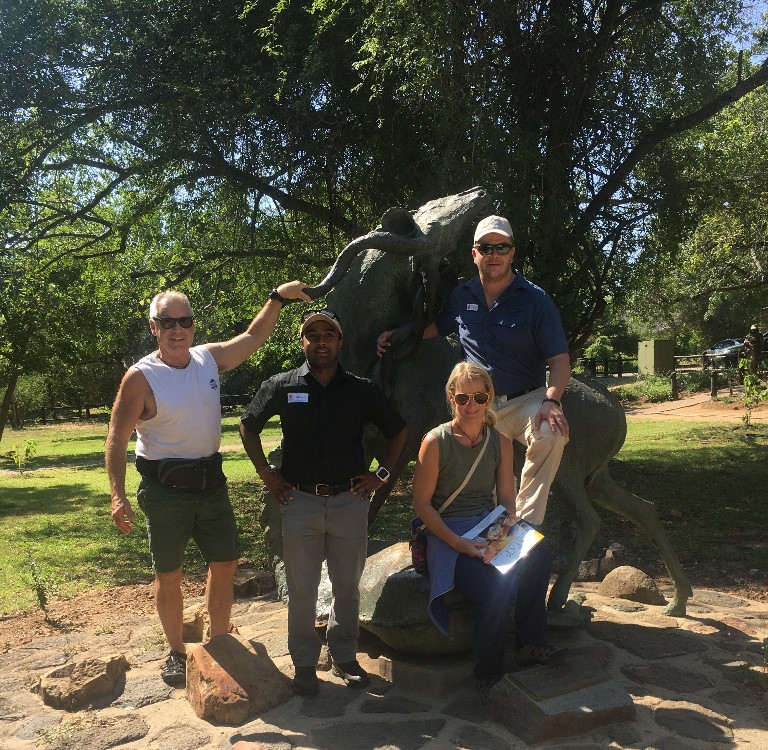
29 October 2018
The Endangered Wildlife Trust (EWT) recently helped to make history in Australia when Constant Hoogstad, Senior Manager: Industry Partnerships, travelled to Tasmania to facilitate the formalisation of a partnership between Raptor Refuge, a local raptor rehabilitation centre, and Tasmania’s electricity company, TasNetworks.
The Eskom/EWT strategic partnership is an example of what can be achieved when industries and conservationists work towards a common goal, and has been addressing electricity infrastructure impacts in South Africa for the last 22 years. The partnership started working with Raptor Refuge when Craig Webb, founder, reached out to Constant in 2016, sharing his concerns around the electrocution of Endangered Wedge-tailed Eagles in Tasmania. Craig later travelled to South Africa to learn more about the successful partnership first hand, and discover how it could be implemented in Australia.

Craig Webb (Raptor Refuge), Kishaylin Chetty (Eskom), Jodie Nolan, and Constant Hoogstad (EWT)
This highly successful and globally unique model was used as the blueprint to formulate a system to address raptor electrocutions in Tasmania. The South African team provided insight and guidance around solutions to the problem of raptor electrocutions, sharing information on mitigation methods, products, and raptor-friendly structural designs, and relaying the successes achieved and lessons learnt in South Africa through the Eskom/EWT partnership. Nearly two years after the initial contact, Raptor Refuge has officially launched a toll free hotline, allowing members of the public to report incidents in Tasmania, and has signed a formal partnership memorandum of understanding with TasNetworks, modelled on the Eskom/EWT partnership in South Africa.
Information collected about dead raptors will increase the understanding of the threats they face and how they might be prevented. The Australian Minister for Environment, Elise Archer, was in attendance to officially launch the new hotline at Raptor Refuge, following the commitment by TasNetworks to fund the initiative. Raptor Refuge founder, Craig Webb, said, “Meeting the senior environmental advisor, Kishaylin Chetty, from Eskom and Constant Hoogstad and Lourens Leeuwner (Wildlife and Energy Programme Manager) from the EWT, and seeing and feeling how they can work together, gave me great insight and even more determination to make this solution work for our raptors in Tasmania. The support I have received from the EWT is nothing short of outstanding and this had undoubtedly helped forge this partnership. There are 13 birds of prey in Tasmania. Four of these are in decline – the Tasmanian Wedge-tailed Eagle, the Grey Goshawk, the White-bellied Sea Eagle and the Tasmanian Masked Owl. All these birds are at risk of succumbing to either collision with power lines or electrocutions. These threatened birds require a comprehensive state-wide action plan to be saved from extinction.”

Raptor Refuge, Tasmania
Eskom Environmental Manager, Deidre Herbst went on to say, “It is so rewarding to see the work of our partnership going beyond our borders and benefiting other utilities and, of course, our precious wildlife.”
Yolan Friedmann, CEO of the EWT added, “The EWT has always believed in the power of partnerships and what can be achieved when people cast aside differences and work on finding solutions together. The Eskom/EWT partnership has achieved extraordinary conservation wins over the past 20 years, and being given this opportunity to take these learnings and our combined experience, strengths and knowledge to help other passionate conservationists save their own threatened wildlife, gives up hope for a better world for all.”
Back in South Africa, the Eskom/EWT partnership is making great strides towards a wildlife-friendly electricity network. The proactive mitigation strategy, whereby Eskom uses species sensitivity maps developed by the EWT to indicate priority areas and where impacts are most likely to occur, is now in its second year. The magnitude of this task was initially quite overwhelming, but the progress has been impressive. To date over 20,000 power line structures have been replaced, insulated or modified to be bird-friendly, and approximately 190 km of power lines have been fitted with bird flight diverters. This unique approach to mitigation has captured the attention of conservationists and authorities in USA, Canada, Australia, Portugal, Namibia, Jordan, Kenya, Botswana, Lesotho, Zambia and Swaziland, and the partnership is constantly engaging with stakeholders in these countries and encouraging the replication of the partnership model.


